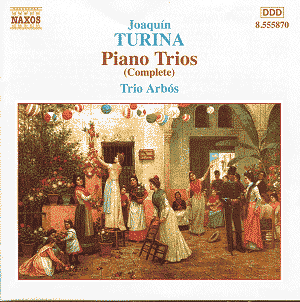Joaquín Turina was one of the major figures
in Spanish music of the 20th century, but relatively little of his substantial
output has achieved international currency. Yet each time one hears
his music, one asks the same question: why is this not better known?
These piano trios, while not all masterpieces, reveal his command of
chamber music.
The earliest of the four pieces, the unpublished Trio
of 1904, receives its first recorded performance here. Although it is
the longest piece on the programme, it is the least interesting, leaving
the listener with the feeling that the composer's evolving technique
was having the upper hand in dominating the level of inspiration.
However, it is a different story in the more tightly
argued pair of trios from 1926 and 1933, and the Fantasy composed in
1936 and entitled Circulo. This deals with imageries associated with
different times of the day (dawn, noon and twilight), and most imaginative
it is too. The clear, ambient recording and the skilful playing of the
Trio Arbós ensure a most pleasing impression.
The Trios Nos. 1 and 2 are more concerned with classical
proportions and schemes. Each of these fine works has its own personality,
and each uses the trio combination with imagination, verve and virtuosity.
The music is always fluent but never short of character, and with committed
playing and good recorded sound at the bargain Naxos price, this disc
can be warmly recommended.
Terry Barfoot
Roy Brewer has also listened to this disc
First a small niggle: on the CD case
Turina’s music is described as "largely nationalist in style".
Well, he certainly composed Spanish-sounding music, as did his
Iberian contemporaries; but Turina was in many respects more cosmopolitan
than any of them. Here the picture postcard Spain of Albéniz
and Granados is replaced by deeper sources of inspiration. Turina trained
in Seville, Madrid and at the Schola Cantorum in Paris, where he studied
with Vincent d’Indy. He was the only notable Spanish composer of his
time to write a symphony, and a friend of several eminent French composers.
Indeed, in places the Trios can sound
more French than Spanish, and their impressionistic harmony more reminiscent
of Ravel than Seville (No. 2, Op. 76 for example) – and even of Poulenc,
in parts of Circulo …. Admittedly a fair amount of music with
a Spanish flavour was written by French composers, among them Bizet,
Lalo, Debussy and Ravel, but Turina reaches more searchingly into the
essentially melancholic elements of the Spanish temperament. There we
encounter an older, darker, more secret Spain, as in the troubled first
movement of No. 1, Op. 35 and the following a set of variations on a
slow theme where ghostly dance rhythms – among them the Habanera, Canarios
and Pavane – lurk in the shadows.
The most interesting, and in some respects
most satisfying, work on this disc, Circulo … , is the latest
(1936). Turina called his piano trio Op, 91 a Fantasy, possibly to avoid
academic criticism, since it is descriptive and not in classical sonata
form. The titles of the three movements – Amanecer, Mediodía
and Crepúsculo – reflect changing moods from dawn to dusk,
though the melodic and harmonic texture is predominantly abstract rather
than pictorial in any natural way. From a sombre dawn, hymned by the
cello, to a Spanish dance rhythm for noon and a tranquil evening this
sequence, used by many composers, is completely free of cliché
and representative of the evocative, inward-looking nature of Turina’s
chamber music.
At 45 the composer was equipped to explore
with confidence the shadowy sound world which much of the music on this
disc inhabits. The extrovert opening of the F major Trio (1904) (the
longest on his disc and here receives its premier recording. It is a
mature work, a portentous opening quickly giving way to tender reflection
followed by a lively Allegro in 5/4 time, the nervous energy
of which is perfectly realised by the Arbós players. The final
movement falls into four contrasting sections, with Turina’s colourful
canvas filled with light and shade. It is astonishing that so attractive
and accessible a work has remained undiscovered by the wider musical
public for almost a century.
Once again Naxos has rediscovered unfamiliar
works by a nowadays unjustly neglected composer. All are well worth
reviving in these excellent interpretations. I recommend listening to
them separately rather than sequentially so that their subtly blended
individual characteristics can be savoured.
Roy D. Brewer


